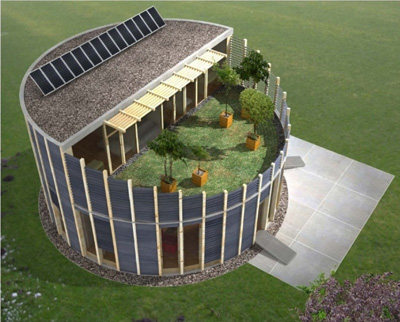Solar energy
The Sun is the basic source of life and the largest supplier of energy needed for life on the Earth. It is inexhaustible, safe and renewable energy source in course of the whole year. Mankind has, since its very beginning, respected Sun as the life-giving body without of which existence of any form of life would not have been possible. Even ancient cultures struggled to exploit the solar energy for their well being (in technology, army or agriculture). Modern times have enabled us to become familiar with the aspects of the solar energy in broader context and also exploit it more effectively.
Solar energy is being exploited in several different ways. It is an integral part of the wind energy, enables to produce heat and electricity or it is the primary prerequisite for the biomass formation.

- Passively (efficient construction of the houses heated by solar energy in such way that the radiation from sun would achieve, in course of its storing and distribution within the building, the maximum effect – ecological houses and so on)
- Actively (solar collectors for heating or plants drying, electricity generation in photovoltaic cells)
- Thermal pumps (air-air , air – water ) exploiting the temperature of the environment
- Industrial heat generation
Solar houses
These are constructed in such way that they exploit maximum of the solar radiation as the economically advantageous resource to heat the house, warm the water or for air conditioning. They are built predominantly in the areas with the high potential of the solar energy. In case of the solar house the adjustment of the solar collectors is of great importance because for the efficient house heating important is also the type of the solar energy.
Known are 3 basic types of the solar energy incidence:
- direct (solar rays hit directly the solar collector),
- diffusion (solar rays hit the earth as dispersed through the clouds),
- reflected (solar rays hit the earth indirectly – for example as reflected from the neighbouring buildings, or water surface).
Solar collectors
Surface of the solar collector is formed of the glass table with the accompanying collector bath. The solar energy heats the liquid in the absorber which is protected by the insulation. Absorber may be in form of the plate or tube. Absorber subsequently transfers the energy via the heat carrying medium to the warm utility and heating water. The efficiency of this process depends on the quality of the solar collector as well as on its location. Therefore the sophisticated absorber, thorough construction solution of the panel as well as high quality insulation of the solar collector will enable to achieve high efficiency in summer and partially also in winter.
Industrial heating
This case calls for the increase in the transformation efficiency even at the account of the higher investments, as industry uses the steam of high temperature and pressure. For that purpose exploited are the steam collectors, where the solar radiation (flow of photons) is concentrated by lenses into one point and there generated is high temperature sufficient for the steam production. In some cases such facility can be used for the metals melting.
An interesting chapter among the examples of the solar energy exploitation is the greenhouse. It is applied mainly in the agriculture and botany.
Photovoltaic cells

Among the disadvantages of the solar energy is that when we need it mostly, it is missing. Storing the solar energy is an important part of all facilities operating on such energy. One method of its storing is its transformation into the electricity which can be “stored” for the longer period in the batteries (electrical accumulators).
The transformation of the solar energy in electrical one is carried out in the photovoltaic cells, the basic part of which forms the semiconductor element, similar to the photodiode, where the flow of photons is directly transformed in the flow of electrons expressed as the electricity. Photons posses the energy which is passed to the electrons to overpower the inner forces for them to get free.
Electrical energy from the solar radiation is transformed into applicable form in the power electronics so that it can be exploited in the conventional electricity systems. See the scheme of the photovoltaic cell connection in the transducer DC/AC.
Nowadays, in the regions with the sufficient sun radiation, they build big power stations with the capacity of several MW.
Drawback of the photovoltaic cells is the low percentage of the solar energy conversion in the electricity. Recent conversion reaches in average from 12 to 18%, based on the applied material. The research into this field could bring in future the materials that would gain transformation up to 35%, providing more efficient generation of the electricity.



